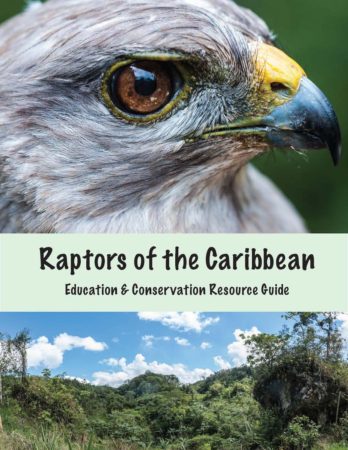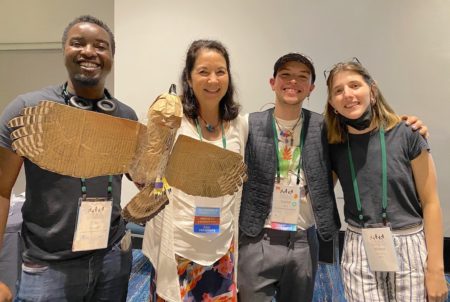
Marta Curti of the Peregrine Fund shares her thoughts on (and love for) our magnificent Caribbean raptors, including several threatened endemic species and subspecies; and introduces a brand new Resource Guide, which will help conservationists, educators, and community members understand raptors better.
I am just going to say it. Raptors are cool! Their laser-like eyesight, powerful hunting skills, acrobatic and graceful flight, coupled with their penetrating stare, have been a source of fascination for humans probably since the first time someone locked eyes with one of these spectacular birds. But they are so much more than attractive and awe-inspiring birds.
More and more research has shown the important roles raptors play in the ecosystems in which they live. They act as top predators, bio-indicators, and umbrella species. They provide important ecosystem services for humans, and many are keystone species. In short, their role in an ecosystem is large in comparison to their numbers and their removal from that system would cause a cascade of negative effects on numerous other organisms – including humans.
Despite this, raptors are one of the most threatened bird groups in the world. And raptors in the Caribbean are no different. Populations across the region are in decline and there are even several endemic species and subspecies that need our help. These include the Ridgway’s Hawk, Cuban Kite, Grenada Hook-billed Kite, and Puerto Rican Sharp-shinned Hawk. With this in mind, you would imagine that the study of raptors and conservation programs to protect them would be widespread. But sadly, despite the critical roles they play in our ecosystems, and the many threats they face, there are few research and environmental education programs focused on raptors across the Caribbean.
We set out to change all of that.
Together with support from BirdsCaribbean, we at The Peregrine Fund have written a 200-page training manual entitled “Raptors of the Caribbean: Education and Conservation Resource Guide.” The guide is divided into four chapters:
- What are Birds of Prey,
- Identification of Birds of Prey of the Caribbean,
- Why Raptors Matter, and
- How One Can Help Conserve Raptors.
Each chapter is followed by two learning activities and one evaluation activity, as well as additional learning materials. Though written in English, we are now in the process of translating it into Spanish and Haitian Creole (Kreyòl), so it will have greater impact throughout the Caribbean.
But the creation of the guide is just the first step. The next stage is to train conservationists, community leaders, and educators in its use. During the AOS-BirdsCaribbean Conference in Puerto Rico in June 2022, we held a condensed workshop for 12 participants. After a short presentation on birds of prey, the action started. We began by breaking into teams and building life-sized raptors out of recyclable materials. Participants created a Stygian Owl, a Ridgway’s Hawk, and even a massive Secretarybird out of nothing but cardboard, plastic bottles, newspaper, and some tape to hold them all together. Creativity took flight!
For the next activity, groups reviewed the guide and chose an activity they were going to teach to the rest of us. We played games, wrote poems, and engaged in a “memory” challenge. One participant kept repeating “I am having so much fun!” A positive sign indeed!
We had carried out a pre- and post-evaluation and saw that in the four short hours of the mini-workshop, participants learned a lot about raptors that they hadn’t known before – such as what they eat, where they live, and the important functions they perform in their environment. It was an intense, hands-on learning experience.
Thanks to support from BirdsCaribbean and the Betty Petersen Conservation Fund, the manual is now completed. Our dream is to carry out extended workshops of two or more days in countries around the Caribbean. Participants will gain experience – including conservation-based lessons that use raptors to teach math, language, art, and even physical education in their programs.

In these longer workshops, we aim to offer participants training in environmental education techniques and methods. These would include developing a guided nature walk; giving an impactful presentation; how to speak about sensitive issues one-on-one with community members; and utilizing whatever materials are available on-hand to create fun and dynamic learning experiences for participants’ target audiences. They would also learn about raptors in their countries, food chains, threats to wildlife, and possible conservation solutions.
Several participants from each country would then be trained to lead these workshops, so we can form a chain of raptor-based environmental education workshops throughout the Caribbean and help to promote interest in raptor research and conservation. From our understanding, this is the only raptor-based conservation-themed workshop in the region. We are excited to embark on these workshops and look forward to sharing our results!
We are currently raising funds to make these education workshops a reality. Ongoing training is so vital to ensure the long-term survival of these magnificent birds. If you would like to support this work, please click here.
The “Raptors of the Caribbean” Training Manual and Guide is currently undergoing a final review, and will be available for FREE download in late September, 2022. Stay tuned!






